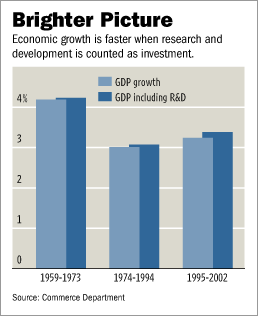 Source of graphic: online version of WSJ article cited below.
Source of graphic: online version of WSJ article cited below.
Note well Romer’s caveat below that, although we may be measuring better, we are still not measuring Schumpeterian innovations (such as the Wal-Mart innovations that are vastly increasing the efficiency of retailing).
That research and development makes an important contribution to U.S. economic growth has long been obvious. But in an important advance, the nation’s economic scorekeepers declared they can now measure that contribution and found that it is increasing.
. . .
Since the 1950s, economists have explained economic output as the result of measurable inputs. Any increase in output that can’t be explained by capital and labor is called "multifactor productivity" or "the Solow residual," after Robert Solow, the Nobel Prize-winning economist considered the father of modern growth theory.
From 1959 to 2002, this factor accounted for about 20% of U.S. growth. From 1995 to 2002, when productivity growth accelerated sharply, that grew to about 33%. Accounting for R&D would explain about one-fifth, by some measures, of the productivity mystery. It suggests companies have been investing more than the official data had previously shown — a good omen for future economic growth. "The slump in investment is not as drastic as people thought before they saw these figures," says Dale Jorgenson, professor of economics at Harvard University.
Mr. Jorgenson noted a lot of the multifactor productivity growth remains unexplained. "The great mystery of growth . . . is not eliminated."
Paul Romer, an economics professor at Stanford Business School, said the better the measurements of R&D become, the more economists and policy makers will realize other factors may be more important. "If you look at why we had rapid productivity growth in big-box retailing, there were lots of intangibles and ideas that . . . don’t get recorded as R&D."
For the full story, see:
(Note: The slightly different online version of the title is: "Why Economists Track Firms’ R&D; Data on Knowledge Creation Point to an Increasing Role In Domestic Product Growth.")
(Note: ellipses in Jorgenson and Romer quotes, in original; ellipsis between paragraphs, added.)

